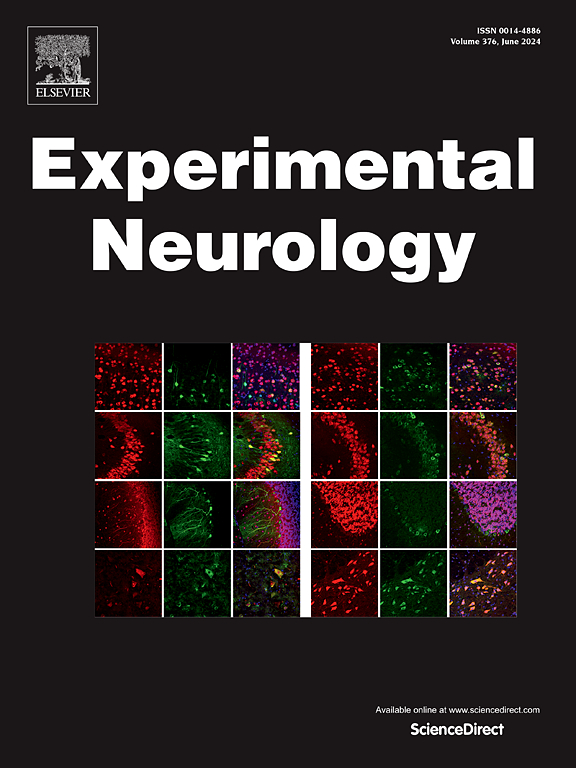Crosstalk between lipocalin-2 and IL-6 in traumatic brain injury: Closely related biomarkers
IF 4.6
2区 医学
Q1 NEUROSCIENCES
引用次数: 0
Abstract
Clinical biomarkers are crucial for diagnosing and predicting outcomes in patients with traumatic brain injury (TBI). In this study, we performed an unbiased analysis of plasma proteins in acute TBI patients using bead-based multiplex assays and identified a strong positive correlation between LCN2 and IL-6 levels. Based on these findings, we hypothesized that LCN2 and IL-6 are closely related circulating biomarkers for TBI. Our previous and current studies demonstrate that the expression of LCN2, IL-6, and its receptors is upregulated in patients with chronic traumatic encephalopathy, in mouse models of traumatic and ischemic injury, and in an in vitro scratch injury model. Lcn2-deficiency reduced the injury-induced expression of IL-6 and its receptors in both animal and scratch injury models. These results suggest an augmented LCN2-dependent IL-6 signaling in the injured brain. As both LCN2 and IL-6 are secreted proinflammatory mediators, we further explored the possibility of cross-regulation between LCN2 and IL-6. In cultured glial cells, treatment with recombinant LCN2 protein enhanced the microglial expression of IL-6, while IL-6 protein treatment increased astrocytic LCN2 expression. Moreover, IL-6 expression and release were elevated in LCN2-overexpressing transgenic mice. Mechanistically, IL-6 enhanced astrocytic LCN2 expression through STAT3 signaling, while LCN2 upregulated microglial IL-6 expression through the NF-κB pathway. Taken together, our results suggest an important role of the LCN2-IL-6 axis in amplifying neuroinflammation through a positive feedback loop in secondary brain injury conditions. Finally, this study implies the utility of LCN2 and IL-6 as closely related biomarkers for TBI diagnosis and prognosis.
创伤性脑损伤中脂钙素-2和IL-6之间的串扰:密切相关的生物标志物。
临床生物标志物对于诊断和预测创伤性脑损伤(TBI)患者的预后至关重要。在这项研究中,我们对急性TBI患者的血浆蛋白进行了无偏分析,使用基于头部的多重检测,发现LCN2和IL-6水平之间存在强烈的正相关。基于这些发现,我们假设LCN2和IL-6是与TBI密切相关的循环生物标志物。我们之前和目前的研究表明,LCN2、IL-6及其受体在慢性创伤性脑病患者、创伤性和缺血性损伤小鼠模型以及体外抓伤模型中表达上调。lcn2缺失降低了IL-6及其受体在动物和抓伤模型中的表达。这些结果表明损伤脑中lcn2依赖性IL-6信号的增强。由于LCN2和IL-6都是分泌促炎介质,我们进一步探索了LCN2和IL-6之间交叉调控的可能性。在培养的胶质细胞中,重组LCN2蛋白处理增强了小胶质细胞IL-6的表达,而IL-6蛋白处理增加了星形胶质细胞LCN2的表达。此外,过表达lcn2的转基因小鼠IL-6的表达和释放均升高。在机制上,IL-6通过STAT3信号通路增强星形胶质细胞LCN2的表达,而LCN2通过NF-κB途径上调小胶质细胞IL-6的表达。综上所述,我们的研究结果表明,LCN2-IL-6轴在继发性脑损伤条件下通过正反馈回路放大神经炎症中发挥了重要作用。最后,本研究表明LCN2和IL-6是TBI诊断和预后密切相关的生物标志物。
本文章由计算机程序翻译,如有差异,请以英文原文为准。
求助全文
约1分钟内获得全文
求助全文
来源期刊

Experimental Neurology
医学-神经科学
CiteScore
10.10
自引率
3.80%
发文量
258
审稿时长
42 days
期刊介绍:
Experimental Neurology, a Journal of Neuroscience Research, publishes original research in neuroscience with a particular emphasis on novel findings in neural development, regeneration, plasticity and transplantation. The journal has focused on research concerning basic mechanisms underlying neurological disorders.
 求助内容:
求助内容: 应助结果提醒方式:
应助结果提醒方式:


